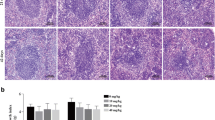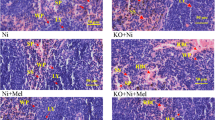Abstract
Aluminum (Al) is widely used in daily life and was recently recognized as a possible source of human intoxication because of its ability to accumulate in organs. The objective of the present study was to investigate the effects of subchronic Al overload on splenic immune function in mice. Furthermore, we have preliminarily explored its mechanism. The Al overload model was established via intragastric administration of Al once a day for 60 days. The body weight, spleen weight, and splenic coefficient were determined. The concentration of Al in the spleen was detected by inductively coupled plasma-mass spectrometry. The cytokine mRNA expression of spleen tissues was detected by reverse transcription-quantitative polymerase chain reaction (RT-qPCR). Biochemical methods were used to detect superoxide dismutase (SOD), glutathione peroxidase (GSH-Px), and malondialdehyde (MDA) contents in spleen tissue. Body weight, spleen weight, and cytokine mRNA expression of spleen tissues were significantly reduced by Al overload. SOD and GSH-Px activities were also decreased, while the MDA content was increased in subchronic Al overload mice. The results indicate that subchronic exposure to aluminum trichloride (AlCl3) would result in Al accumulation, which suppressed spleen immune function through a mechanism related to oxidative stress.




Similar content being viewed by others
References
Walton JR (2006) Aluminum in hippocampal neurons from humans with Alzheimer’s disease. Neurotoxicology 27(3):385–394. doi:10.1016/j.neuro.2005.11.007
Kawahara M, Kato M, Kuroda Y (2001) Effects of aluminum on the neurotoxicity of primary cultured neurons and on the aggregation of beta-amyloid protein. Brain Res Bull 55(2):211–217
Rondeau V, Jacqmin-Gadda H, Commenges D, Helmer C, Dartigues JF (2009) Aluminum and silica in drinking water and the risk of Alzheimer’s disease or cognitive decline: findings from 15-year follow-up of the PAQUID cohort. Am J Epidemiol 169(4):489–496. doi:10.1093/aje/kwn348
Li X, Hu C, Zhu Y, Sun H, Li Y, Zhang Z (2011) Effects of aluminum exposure on bone mineral density, mineral, and trace elements in rats. Biol Trace Elem Res 143(1):378–385. doi:10.1007/s12011-010-8861-4
Zhang L, Li X, Gu Q, Zhu Y, Zhao H, Li Y, Zhang Z (2011) Effects of subchronic aluminum exposure on serum concentrations of iron and iron-associated proteins in rats. Biol Trace Elem Res 141(1–3):246–253. doi:10.1007/s12011-010-8725-y
Wang N, She Y, Zhu Y, Zhao H, Shao B, Sun H, Hu C, Li Y (2012) Effects of subchronic aluminum exposure on the reproductive function in female rats. Biol Trace Elem Res 145(3):382–387. doi:10.1007/s12011-011-9200-0
Zhu Y, Zhao H, Li X, Zhang L, Hu C, Shao B, Sun H, Bah AA, Li Y, Zhang Z (2011) Effects of subchronic aluminum exposure on the immune function of erythrocytes in rats. Biol Trace Elem Res 143(3):1576–1580. doi:10.1007/s12011-011-8964-6
Zhu Y, Hu C, Li X, Shao B, Sun H, Zhao H, Li Y (2012) Suppressive effects of aluminum trichloride on the T lymphocyte immune function of rats. Food Chem Toxicol 50(3–4):532–535. doi:10.1016/j.fct.2011.12.007
She Y, Wang N, Chen C, Zhu Y, Xia S, Hu C, Li Y (2012) Effects of aluminum on immune functions of cultured splenic T and B lymphocytes in rats. Biol Trace Elem Res 147(1–3):246–250. doi:10.1007/s12011-011-9307-3
Tzanno-Martins C, Azevedo LS, Tanji M, Tanji MC, Sabbaga E, Marcondes M, Duarte AJ (1995) The role of experimental aluminum intoxication in allogeneic immunoresponse. Transpl Int 8(5):396–398
Becaria A, Campbell A, Bondy SC (2002) Aluminum as a toxicant. Toxicol Ind Health 18(7):309–320
Hirota K, Hirota T (2006) Nutrition-related bone disease. Nihon Rinsho 64(9):1707–1711
Thomas WC, Meyer JL (1984) Aluminum-induced osteomalacia: an explanation. Am J Nephrol 4(3):201–203
Jeffery EH, Abreo K, Burgess E, Cannata J, Greger JL (1996) Systemic aluminum toxicity: effects on bone, hematopoietic tissue, and kidney. J Toxicol Environ Health 48(6):649–665
Kutlubay R, Oguz EO, Guven C, Can B, Sinik Z, Tuncay OL (2007) Histological and ultrastructural evidence for protective effects on aluminium-induced kidney damage by intraperitoneal administration of alpha-tocopherol. Int J Toxicol 26(2):95–101. doi:10.1080/10915810701221173
Golub MS, Takeuchi PT, Gershwin ME, Yoshida SH (1993) Influence of dietary aluminum on cytokine production by mitogen-stimulated spleen cells from Swiss Webster mice. Immunopharmacol Immunotoxicol 15(5):605–619. doi:10.3109/08923979309019733
Bondy SC, Guo-Ross SX, Pien J (1998) Mechanisms underlying the aluminum-induced potentiation of the pro-oxidant properties of transition metals. Neurotoxicology 19(1):65–71
Ferretti G, Marchionni C, Bacchetti T, Galeazzi T, Dousset N (2003) Effect of aluminium on lipid peroxidation of human high density lipoproteins. Free Radic Res 37(5):515–521
Ferretti G, Bacchetti T, Marchionni C, Dousset N (2004) Effect of non-enzymatic glycation on aluminium-induced lipid peroxidation of human high density lipoproteins (HDL). Nutr Metab Cardiovasc Dis 14(6):358–365
Vasudevaraju P, Govindaraju M, Palanisamy AP, Sambamurti K, Rao KS (2008) Molecular toxicity of aluminium in relation to neurodegeneration. Indian J Med Res 128(4):545–556
Verstraeten SV, Aimo L, Oteiza PI (2008) Aluminium and lead: molecular mechanisms of brain toxicity. Arch Toxicol 82(11):789–802. doi:10.1007/s00204-008-0345-3
Deng Y, Zhang Y, Jia S, Liu J, Liu Y, Xu W, Liu L (2013) Effects of aluminum and extremely low frequency electromagnetic radiation on oxidative stress and memory in brain of mice. Biol Trace Elem Res 156(1–3):243–252. doi:10.1007/s12011-013-9847-9
Garcia-Medina S, Razo-Estrada AC, Gomez-Olivan LM, Amaya-Chavez A, Madrigal-Bujaidar E, Galar-Martinez M (2010) Aluminum-induced oxidative stress in lymphocytes of common carp (Cyprinus carpio). Fish Physiol Biochem 36(4):875–882. doi:10.1007/s10695-009-9363-1
Yousef MI (2004) Aluminium-induced changes in hemato-biochemical parameters, lipid peroxidation and enzyme activities of male rabbits: protective role of ascorbic acid. Toxicology 199(1):47–57. doi:10.1016/j.tox.2004.02.014
Fang X, Feng Y, Wang J, Dai J (2010) Perfluorononanoic acid-induced apoptosis in rat spleen involves oxidative stress and the activation of caspase-independent death pathway. Toxicology 267(1–3):54–59. doi:10.1016/j.tox.2009.10.020
Jia J, Wu YH, Zhou XQ, Wang Y (2012) Effects of testosterone propionate on oxidative stress and the expression of spleen cytokine genes in endosulfan-treated mice. J Environ Pathol Toxicol Oncol 31(1):17–26
Kubrak OI, Husak VV, Rovenko BM, Poigner H, Mazepa MA, Kriews M, Abele D, Lushchak VI (2012) Tissue specificity in nickel uptake and induction of oxidative stress in kidney and spleen of goldfish Carassius auratus, exposed to waterborne nickel. Aquat Toxicol 118–119:88–96. doi:10.1016/j.aquatox.2012.03.016
Acknowledgments
The International Science Editing, Ireland, is gratefully acknowledged for editing the manuscript. This work was supported by a grant from the Third Military Medical University (grant number 2012XJQ07) and the National Natural Science Foundation of China (grant number 81302413).
Conflict of Interest
The authors report no conflicts of interest. The authors alone are responsible for the content and writing of the paper. The authors declared that they have no financial and personal relationships with other people or the organizations that can inappropriately influence their work. There is no professional or other personal interest of any nature or kind in any product, service, and/or company.
Author information
Authors and Affiliations
Corresponding author
Rights and permissions
About this article
Cite this article
Luo, X., Jia, S., Ma, Q. et al. Suppressive Effects of Subchronic Aluminum Overload on the Splenic Immune Function May Be Related to Oxidative Stress in Mice. Biol Trace Elem Res 157, 249–255 (2014). https://doi.org/10.1007/s12011-014-9888-8
Received:
Accepted:
Published:
Issue Date:
DOI: https://doi.org/10.1007/s12011-014-9888-8




